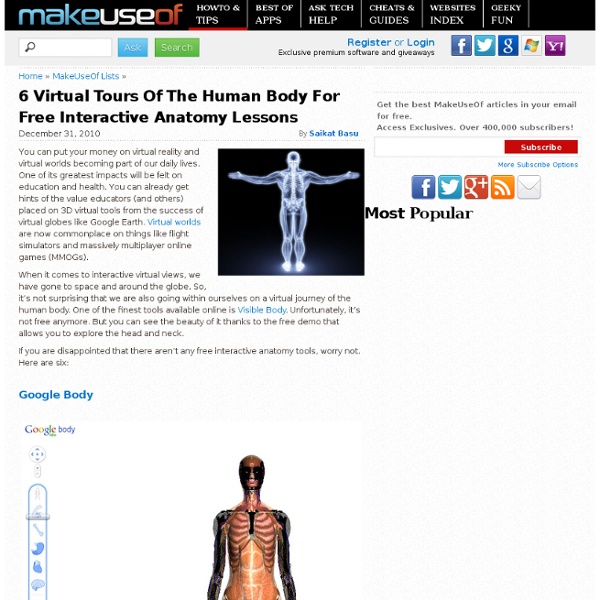50 Really Cool Online Tools for Science Teachers
A 21st-century education revolves around the Internet for everything from collaboration, tools, lessons, and even earning degrees online. If you are looking for ways to integrate online learning into your science class or science degree programs, then take a look at these cool online tools that are just perfect for both teachers and students. Science Tools to Use with Students These tools offer opportunities for learning about climate, cells, the human body, nature, and more.
OnLineLabs
ChemLab There is a fee for this one, but it is well worth the price! They are truly interactive and you can design your own simulations! Go to the downloads page for a free evaluation trial Dartmouth ChemLab This site has some very good interactive virtual labs plus a terrific interactive periodic table!
Your Amazing Bran
The first stop on the virtual brain tour takes a look at the three main parts of the brain, the cerebral cortex, the cerebellum and the brain stem. It also explores the four brain lobes: the frontal lobe, the parietal lobe, the temporal lobe and the occipital lobe. The first part of the brain to evolve some 500 million years ago was the brain stem. It is also known as the reptilian brain or lower brain. Certain ‘hardwired’ body functions e.g., breathing and blood pressure, as well as some basic human instincts like danger are controlled by the lower brain. The cerebellum evolved about 400 million years ago and is also known as the hind brain.
Neurological Control - Neurotransmitters
Neurotransmitter Molecules Neurotransmitters can be broadly split into two groups – the ‘classical’, small molecule neurotransmitters and the relatively larger neuropeptide neurotransmitters. Within the category of small molecule neurotransmitters, the biogenic amines (dopamine, noradrenaline, serotonin and histamine) are often referred to as a discrete group because of their similarity in terms of their chemical properties. Click on the links in the table above to read more about some of the important neurotransmitters. Serotonin
Newton's Laws of Motion
The motion of an aircraft through the air can be explained and described by physical principals discovered over 300 years ago by Sir Isaac Newton. Newton worked in many areas of mathematics and physics. He developed the theories of gravitation in 1666, when he was only 23 years old. Some twenty years later, in 1686, he presented his three laws of motion in the "Principia Mathematica Philosophiae Naturalis." The laws are shown above, and the application of these laws to aerodynamics are given on separate slides. Newton's first law states that every object will remain at rest or in uniform motion in a straight line unless compelled to change its state by the action of an external force.
: Tutorials
LeChatlier's Principle Concentration Discusses how LeChatelier's principle applies when the "stress" to a system at equilibrium is a change in concentration of products or reactants. LeChatlier's Principle: Hemoglobin scenario Chemists use LeChatelier's principle to reason qualitatively about the influence of changes in concentration, temperature or pressure on systems that are at equilibrium. This movie describes the hemoglobin scenario… Using LeChatlier's Principle Introduces the general formulation of Le Chatlier's principle. LeChatlier's principle is a general and very powerful framework for making predictions about the effects of stress is on chemical systems. Reversible Reactions Gives a more general overview of reversible reactions and the concept of chemical equilibrium.
List all the essential neurotransmitters
Acetylcholine - synthesized from Choline, Lecithin, and panthothenic acid (B5), or Diethylaminoethanol (DMAE) - Arousal and orgasm - voluntary muscular control and proper tone - enhance energy and stamina - memory - long-term planning - mental focus Dopamine - synthesized from amino acid Levodopa - Alertness - Motivation - motor control - immune function - Ego hardening, confidence, optimism - Sexual Desire - Fat gain and loss - lean muscle gain - Bone density - ability to sleep soundly - Inhibits prolactin - thinking, planning, and problem solving - Aggression - Increase psychic and creative ability - Reduction of compulsivety - Salience and paranoia - Processing of pain - Increase sociability Serotonin (5-HT) - Synthesized from amino acid L-tryptophan with co-factor Niacin (B3), through the intermediate 5-hydroxytryptophan (5-HTP)
bodies-in-motion - scott-eaton.com
30 second sequences from BiM Not long ago, I had twelve artists from Natural Motion (of Morpheme and Clumsy Ninja fame) into Somerset House, my home away from home, for a four day anatomy workshop. At the end of each day we would take about 20 minutes to draw from the Bodies in Motion library. sketching from BiM We made extensive use of the timer for gesture drawing. It can be set to 10fps, 1fps, 30sec, 1min, 2min, or 5mins, and ticks down to zero before flipping to the next frame of the motion sequence.



